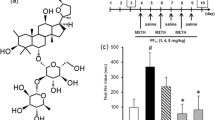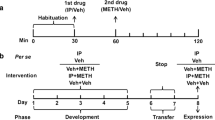Abstract
Rationale
Hispidulin is a flavonoid we isolated from Clerodendrum inerme, an herb that effectively remitted a case of intractable motor tic disorders. Hispidulin was shown to be a positive allosteric modulator (PAM) of GABAA receptors, including the α6 subunit-containing subtype (α6GABAAR) that is predominantly expressed in cerebellar granule cells and insensitive to diazepam.
Objectives
We explored the action mechanism(s) of hispidulin using hyperdopaminergic mouse models induced by methamphetamine and apomorphine, based on the hyperdopaminergic nature of tic disorders.
Results
Hispidulin significantly inhibited methamphetamine-induced hyperlocomotion (MIH) at i.p. doses without affecting apomorphine-induced hyperlocomotion and stereotypy behaviors or having significant benzodiazepine-like effects (BZLE), including sedation, anxiety, and motor impairment. When given by intracerebellar (i.c.b.) microinjection, hispidulin also alleviated MIH and this effect was prevented by i.c.b. coadministration of furosemide, an α6GABAAR antagonist, and mimicked by i.c.b. Ro 15-4513, an α6GABAAR PAM. Conversely, i.c.b. diazepam did not affect MIH while it reduced MIH at i.p. doses having significant BZLE. In a screening assay for 92 neurotransmitter receptors/degradation enzymes/transporters, hispidulin displayed significant (>50 % inhibition of radiolabeled ligand binding at 10 μM) binding affinity only at the benzodiazepine binding site of GABAARs (IC50 0.73∼1.78 μM) and catecholamine-o-methyl-transferase (COMT) (IC50 1.32 μM). OR-486, a more potent COMT inhibitor than hispidulin, did not affect MIH.
Conclusions
It is suggested that hispidulin alleviates MIH via acting as a PAM of cerebellar α6GABAARs, but not through COMT inhibition or affecting dopamine receptor responsiveness. Thus, selective α6GABAAR PAMs may have the potential to be a novel treatment for hyperdopaminergic disorders.





Similar content being viewed by others
Abbreviations
- α6GABAARs:
-
α6 Subunit-containing GABAA receptors
- AIH:
-
Apomorphine-induced hyperlocomotion
- AIS:
-
Apomorphine-induced stereotypy behaviors
- CI :
-
Clerodendrum inerme
- COMT:
-
Catechol-O-methyltransferase
- MIH:
-
Methamphetamine-induced hyperlocomotion
- PAM:
-
Positive allosteric modulator
- TS:
-
Tourette syndrome
References
Bolam JP, Hanley JJ, Booth PA, Bevan MD (2000) Synaptic organisation of the basal ganglia. J Anat 196(Pt 4):527–542
Bronfeld M, Israelashvili M, Bar-Gad I (2013) Pharmacological animal models of Tourette syndrome. Neurosci Biobehav Rev 37:1101–1119
Chen HL, Lee HJ, Huang WJ, Chou JF, Fan PC, Du JC, Ku YL, Chiou LC (2012) Clerodendrum inerme Leaf Extract Alleviates Animal Behaviors, Hyperlocomotion, and Prepulse Inhibition Disruptions, Mimicking Tourette Syndrome and Schizophrenia. Evid Based Complement Alternat Med 2012:284301
Cheon KA, Ryu YH, Namkoong K, Kim CH, Kim JJ, Lee JD (2004) Dopamine transporter density of the basal ganglia assessed with [123I]IPT SPECT in drug-naive children with Tourette’s disorder. Psychiatry Res 130:85–95
Cohen DJ, Shaywitz BA, Caparulo B, Young JG, Bowers MB Jr (1978) Chronic, multiple tics of Gilles de la Tourette’s disease. CSF acid monoamine metabolites after probenecid administration. Arch Gen Psychiatry 35:245–250
Delis F, Mitsacos A, Giompres P (2004) Dopamine receptor and transporter levels are altered in the brain of Purkinje Cell Degeneration mutant mice. Neuroscience 125:255–268
Delis F, Mitsacos A, Giompres P (2013) Lesion of the cerebellar paravermis increases dopamine D1 receptor levels in the contralateral striatum. J Chem Neuroanat 47:35–41
Derry JM, Dunn SM, Davies M (2004) Identification of a residue in the gamma-aminobutyric acid type A receptor alpha subunit that differentially affects diazepam-sensitive and -insensitive benzodiazepine site binding. J Neurochem 88:1431–1438
Fan PC, Huang W-J, Chiou L-C (2009) Intractable chronic motor tics dramatically respond to Clerodendrum inerme (L.) Gaertn. J. Child Neurol 24:887–890
Godar SC, Mosher LJ, Di Giovanni G, Bortolato M (2014) Animal models of tic disorders: a translational perspective. J Neurosci Methods 238:54–69
Gonzales RA, Job MO, Doyon WM (2004) The role of mesolimbic dopamine in the development and maintenance of ethanol reinforcement. Pharmacol Ther 103:121–146
Gutierrez A, Khan ZU, De Blas AL (1996) Immunocytochemical localization of the alpha 6 subunit of the gamma-aminobutyric acidA receptor in the rat nervous system. J Comp Neurol 365:504–510
Hadingham KL, Garrett EM, Wafford KA, Bain C, Heavens RP, Sirinathsinghji DJ, Whiting PJ (1996) Cloning of cDNAs encoding the human gamma-aminobutyric acid type A receptor alpha 6 subunit and characterization of the pharmacology of alpha 6-containing receptors. Mol Pharmacol 49:253–259
Hamann M, Rossi DJ, Attwell D (2002) Tonic and spillover inhibition of granule cells control information flow through cerebellar cortex. Neuron 33:625–633
Hanrahan JR, Chebib M, Johnston GA (2015) Interactions of flavonoids with ionotropic GABA receptors. Adv Pharmacol 72:189–200
Horan P, de Costa BR, Rice KC, Porreca F (1991) Differential antagonism of U69,593- and bremazocine-induced antinociception by (-)-UPHIT: evidence of kappa opioid receptor multiplicity in mice. J Pharmacol Exp Ther 257:1154–1161
Huang WJ, Lee HJ, Chen HL, Fan PC, Ku YL, Chiou LC (2015) Hispidulin, a constituent of Clerodendrum inerme that remitted motor tics, alleviated methamphetamine-induced hyperlocomotion without motor impairment in mice. J Ethnopharmacol 166:18–22
Kaenmaki M, Tammimaki A, Myohanen T, Pakarinen K, Amberg C, Karayiorgou M, Gogos JA, Mannisto PT (2010) Quantitative role of COMT in dopamine clearance in the prefrontal cortex of freely moving mice. J Neurochem 114:1745–1755
Kavvadias D, Monschein V, Sand P, Riederer P, Schreier P (2003) Constituents of sage (Salvia officinalis) with in vitro affinity to human brain benzodiazepine receptor. Planta Med 69:113–117
Kavvadias D, Sand P, Youdim KA, Qaiser MZ, Rice-Evans C, Baur R, Sigel E, Rausch WD, Riederer P, Schreier P (2004) The flavone hispidulin, a benzodiazepine receptor ligand with positive allosteric properties, traverses the blood-brain barrier and exhibits anticonvulsive effects. Br J Pharmacol 142:811–820
Knoflach F, Benke D, Wang Y, Scheurer L, Luddens H, Hamilton BJ, Carter DB, Mohler H, Benson JA (1996) Pharmacological modulation of the diazepam-insensitive recombinant gamma-aminobutyric acidA receptors alpha 4 beta 2 gamma 2 and alpha 6 beta 2 gamma 2. Mol Pharmacol 50:1253–1261
Korpi ER, Kuner T, Seeburg PH, Luddens H (1995) Selective antagonist for the cerebellar granule cell-specific gamma-aminobutyric acid type A receptor. Mol Pharmacol 47:283–289
Kurlan R, Whitmore D, Irvine C, McDermott MP, Como PG (1994) Tourette’s syndrome in a special education population: a pilot study involving a single school district. Neurology 44:699–702
Laurie DJ, Wisden W, Seeburg PH (1992) The distribution of thirteen GABAA receptor subunit mRNAs in the rat brain. III. Embryonic and postnatal development. J Neurosci 12:4151–4172
Marder M, Viola H, Wasowski C, Fernandez S, Medina JH, Paladini AC (2003) 6-methylapigenin and hesperidin: new valeriana flavonoids with activity on the CNS. Pharmacol Biochem Behav 75:537–545
Medina JH, Viola H, Wolfman C, Marder M, Wasowski C, Calvo D, Paladini AC (1997) Overview--flavonoids: a new family of benzodiazepine receptor ligands. Neurochem Res 22:419–425
Mink JW (1996) The basal ganglia: focused selection and inhibition of competing motor programs. Prog Neurobiol 50:381–425
Moufid A, Eddouks M (2012) Artemisia herba alba: a popular plant with potential medicinal properties. Pak J Biol Sci 15:1152–1159
Neuner I, Werner CJ, Arrubla J, Stocker T, Ehlen C, Wegener HP, Schneider F, Shah NJ (2014) Imaging the where and when of tic generation and resting state networks in adult Tourette patients. Front Hum Neurosci 8:362
Nusser Z, Sieghart W, Somogyi P (1998) Segregation of different GABAA receptors to synaptic and extrasynaptic membranes of cerebellar granule cells. J Neurosci 18:1693–1703
Park WK, Jeong D, Yun CW, Lee S, Cho H, Kim GD, Koh HY, Pae AN, Cho YS, Choi KI, Jung JY, Jung SH, Kong JY (2003) Pharmacological actions of a novel and selective dopamine D3 receptor antagonist, KCH-1110. Pharmacol Res 48:615–622
Paxinos G, Franklin KB (2001) The mouse brain in stereotaxic coordinates. Academic Press, San Diego
Pirker S, Schwarzer C, Wieselthaler A, Sieghart W, Sperk G (2000) GABA(A) receptors: immunocytochemical distribution of 13 subunits in the adult rat brain. Neurosci 101:815–850
Sacchetti B, Scelfo B, Strata P (2005) The cerebellum: synaptic changes and fear conditioning. Neuroscientist 11:217–227
Singer HS (2005a) Tourette’s syndrome: from behaviour to biology. Lancet Neurol 4:149–159
Singer HS (2005b) Tourette’s syndrome: from behaviour to biology. Lancet Neurol 4:149–159
Singer HS (2006) Discussing outcome in Tourette syndrome. Arch Pediatr Adolesc Med 160:103–105
Singer HS, Minzer K (2003) Neurobiology of Tourette’s syndrome: concepts of neuroanatomic localization and neurochemical abnormalities. Brain Dev 25(Suppl 1):S70–S84
Singer HS, Szymanski S, Giuliano J, Yokoi F, Dogan AS, Brasic JR, Zhou Y, Grace AA, Wong DF (2002) Elevated intrasynaptic dopamine release in Tourette’s syndrome measured by PET. Am J Psychiatry 159:1329–1336
Swaiman KF, Ashwal S, Ferriero DM (2006) Neurobehavioral disorder in Pediatric neurology: Principles & Practice. Mosby, Elsevier, Philadelphia, p 966
Tsang SY, Xue H (2004) Development of effective therapeutics targeting the GABAA receptor: naturally occurring alternatives. Curr Pharm Des 10:1035–1044
Varagic Z, Ramerstorfer J, Huang S, Rallapalli S, Sarto-Jackson I, Cook J, Sieghart W, Ernst M (2013a) Subtype selectivity of alpha + beta- site ligands of GABAA receptors: identification of the first highly specific positive modulators at alpha6beta2/3gamma2 receptors. Br J Pharmacol 169:384–399
Varagic Z, Wimmer L, Schnurch M, Mihovilovic MD, Huang S, Rallapalli S, Cook JM, Mirheydari P, Ecker GF, Sieghart W, Ernst M (2013b) Identification of novel positive allosteric modulators and null modulators at the GABAA receptor alpha + beta- interface. Br J Pharmacol 169:371–383
Varecka L, Wu CH, Rotter A, Frostholm A (1994) GABAA/benzodiazepine receptor alpha 6 subunit mRNA in granule cells of the cerebellar cortex and cochlear nuclei: expression in developing and mutant mice. J Comp Neurol 339:341–352
Wise RA (2006) Role of brain dopamine in food reward and reinforcement. Philos Trans R Soc Lond B Biol Sci 361:1149–1158
Xu Q, Xie H, Wu P, Wei X (2013) Flavonoids from the capitula of Eriocaulon australe. Food Chem 139:149–154
Acknowledgments
This study was mainly supported by the National Research Program for Biopharmaceuticals (NSC 100-2325-B002-050, NSC 101-2325-B002-048, NSC 102-2325-B002-047, MOST 103-2325-B002-037 and MOST 104-2325-B002-010) and the research grants (MOST 103-2321-B002-035 to LCC; NSC 102-2320-B038-019-MY3 to WJH) from the National Science Council (the Ministry of Science and Technology), Taiwan, as well as by the Innovative Research Grant from National Health Research Institutes, Taiwan (NHRI-EX104-10251NI to LCC). We thank the support from Behavior Core, Neurobiology and Cognitive Center, National Taiwan University.
Author information
Authors and Affiliations
Corresponding author
Ethics declarations
Conflict of interest
All authors declare that they have no conflict of interest.
Electronic Supplementary Materials
Below is the link to the electronic supplementary material.
Supplementary Table S1
Radioligand displacement studies conducted over a broad LeadProfiling and Therapeutic area/CNS Screen by Ricerca Biosciences* (study No. AA95970) to determine the binding affinity/inhibitory activity of hispidulin at 92 receptors, channels, transporters and enzymes. (DOC 107 kb)
Rights and permissions
About this article
Cite this article
Liao, YH., Lee, HJ., Huang, WJ. et al. Hispidulin alleviated methamphetamine-induced hyperlocomotion by acting at α6 subunit-containing GABAA receptors in the cerebellum. Psychopharmacology 233, 3187–3199 (2016). https://doi.org/10.1007/s00213-016-4365-z
Received:
Accepted:
Published:
Issue Date:
DOI: https://doi.org/10.1007/s00213-016-4365-z




